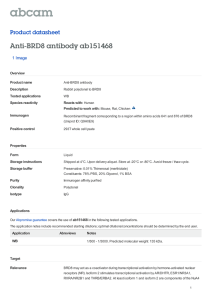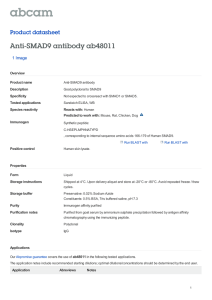Anti-SIRT1 antibody ab12193 Product datasheet 13 Abreviews 6 Images
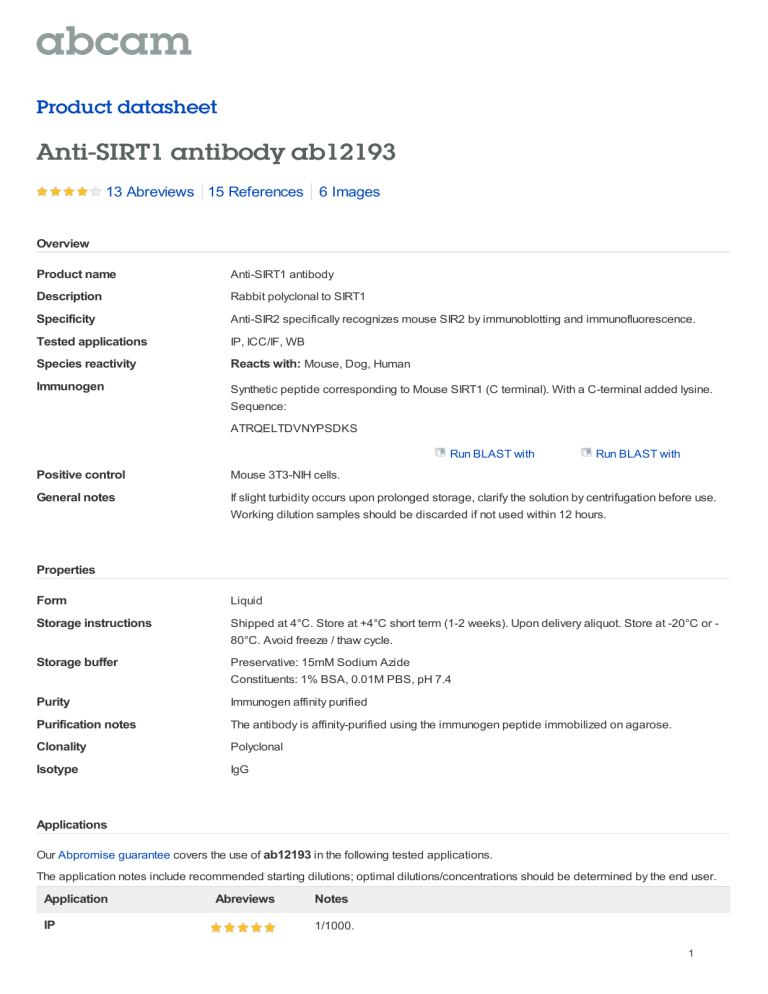
13 Abreviews 15 References 6 Images
Overview
Product name
Description
Specificity
Tested applications
Species reactivity
Immunogen
Positive control
General notes
Anti-SIRT1 antibody
Rabbit polyclonal to SIRT1
Anti-SIR2 specifically recognizes mouse SIR2 by immunoblotting and immunofluorescence.
IP, ICC/IF, WB
Reacts with:
Mouse, Dog, Human
Synthetic peptide corresponding to Mouse SIRT1 (C terminal). With a C-terminal added lysine.
Sequence:
ATRQELTDVNYPSDKS
Run BLAST with Run BLAST with
Mouse 3T3-NIH cells.
If slight turbidity occurs upon prolonged storage, clarify the solution by centrifugation before use.
Working dilution samples should be discarded if not used within 12 hours.
Properties
Form
Storage instructions
Storage buffer
Purity
Purification notes
Clonality
Isotype
Liquid
Shipped at 4°C. Store at +4°C short term (1-2 weeks). Upon delivery aliquot. Store at -20°C or -
80°C. Avoid freeze / thaw cycle.
Preservative: 15mM Sodium Azide
Constituents: 1% BSA, 0.01M PBS, pH 7.4
Immunogen affinity purified
The antibody is affinity-purified using the immunogen peptide immobilized on agarose.
Polyclonal
IgG
Applications
Our Abpromise guarantee covers the use of
ab12193
in the following tested applications.
The application notes include recommended starting dilutions; optimal dilutions/concentrations should be determined by the end user.
Application Abreviews Notes
IP
1/1000.
1
Application
ICC/IF
WB
Target
Function
Abreviews Notes
1/50. (determined by indirect immunofluorescent staining of methanol fixed cultured mouse 3T3-NIH cells).
1/2000. Predicted molecular weight: 80 kDa. (nuclear extract of mouse 3T3-NIH cells). Observed molecular weight is 110 kDa. In some preparations additional lower bands may be detected.
NAD-dependent protein deacetylase that links transcriptional regulation directly to intracellular energetics and participates in the coordination of several separated cellular functions such as cell cycle, response to DNA damage, metobolism, apoptosis and autophagy. Can modulate chromatin function through deacetylation of histones and can promote alterations in the methylation of histones and DNA, leading to transcriptional repression. Deacetylates a broad range of transcription factors and coregulators, thereby regulating target gene expression positively and negatively. Serves as a sensor of the cytosolic ratio of NAD(+)/NADH which is altered by glucose deprivation and metabolic changes associated with caloric restriction. Is essential in skeletal muscle cell differentiation and in response to low nutrients mediates the inhibitory effect on skeletal myoblast differentiation which also involves 5'-AMP-activated protein kinase (AMPK) and nicotinamide phosphoribosyltransferase (NAMPT). Component of the eNoSC (energy-dependent nucleolar silencing) complex, a complex that mediates silencing of rDNA in response to intracellular energy status and acts by recruiting histone-modifying enzymes. The eNoSC complex is able to sense the energy status of cell: upon glucose starvation, elevation of NAD(+)/NADP(+) ratio activates SIRT1, leading to histone H3 deacetylation followed by dimethylation of H3 at 'Lys-9' (H3K9me2) by SUV39H1 and the formation of silent chromatin in the rDNA locus. Deacetylates 'Lys-266' of SUV39H1, leading to its activation. Inhibits skeletal muscle differentiation by deacetylating PCAF and MYOD1.
Deacetylates H2A and 'Lys-26' of HIST1H1E. Deacetylates 'Lys-16' of histone H4 (in vitro).
Involved in NR0B2/SHP corepression function through chromatin remodeling: Recruited to LRH1 target gene promoters by NR0B2/SHP thereby stimulating histone H3 and H4 deacetylation leading to transcriptional repression. Proposed to contribute to genomic integrity via positive regulation of telomere length; however, reports on localization to pericentromeric heterochromatin are conflicting. Proposed to play a role in constitutive heterochromatin (CH) formation and/or maintenance through regulation of the available pool of nuclear SUV39H1.
Upon oxidative/metabolic stress decreases SUV39H1 degradation by inhibiting SUV39H1 polyubiquitination by MDM2. This increase in SUV39H1 levels enhances SUV39H1 turnover in
CH, which in turn seems to accelerate renewal of the heterochromatin which correlates with greater genomic integrity during stress response. Deacetylates 'Lys-382' of p53/TP53 and impairs its ability to induce transcription-dependent proapoptotic program and modulate cell senescence. Deacetylates TAF1B and thereby represses rDNA transcription by the RNA polymerase I. Deacetylates MYC, promotes the association of MYC with MAX and decreases
MYC stability leading to compromised transformational capability. Deacetylates FOXO3 in response to oxidative stress thereby increasing its ability to induce cell cycle arrest and resistance to oxidative stress but inhibiting FOXO3-mediated induction of apoptosis transcriptional activity; also leading to FOXO3 ubiquitination and protesomal degradation.
Appears to have a similar effect on MLLT7/FOXO4 in regulation of transcriptional activity and apoptosis. Deacetylates DNMT1; thereby impairs DNMT1 methyltransferase-independent transcription repressor activity, modulates DNMT1 cell cycle regulatory function and DNMT1mediated gene silencing. Deacetylates RELA/NF-kappa-B p65 thereby inhibiting its transactivating potential and augments apoptosis in response to TNF-alpha. Deacetylates
HIF1A, KAT5/TIP60, RB1 and HIC1. Deacetylates FOXO1 resulting in its nuclear retention and
2
enhancement of its transcriptional activity leading to increased gluconeogenesis in liver. Inhibits
E2F1 transcriptional activity and apoptotic function, possibly by deacetylation. Involved in HES1and HEY2-mediated transcriptional repression. In cooperation with MYCN seems to be involved in transcriptional repression of DUSP6/MAPK3 leading to MYCN stabilization by phosphorylation at 'Ser-62'. Deacetylates MEF2D. Required for antagonist-mediated transcription suppression of AR-dependent genes which may be linked to local deacetylation of histone H3. Represses HNF1A-mediated transcription. Required for the repression of ESRRG by CREBZF. Modulates AP-1 transcription factor activity. Deacetylates NR1H3 AND NR1H2 and deacetylation of NR1H3 at 'Lys-434' positively regulates transcription of NR1H3:RXR target genes, promotes NR1H3 proteosomal degradation and results in cholesterol efflux; a promoter clearing mechanism after reach round of transcription is proposed. Involved in lipid metabolism.
Implicated in regulation of adipogenesis and fat mobilization in white adipocytes by repression of PPARG which probably involves association with NCOR1 and SMRT/NCOR2. Deacetylates
ACSS2 leading to its activation, and HMGCS1. Involved in liver and muscle metabolism.
Through deacteylation and activation of PPARGC1A is required to activate fatty acid oxidation in skeletel muscle under low-glucose conditions and is involved in glucose homeostasis. Involved in regulation of PPARA and fatty acid beta-oxidation in liver. Involved in positive regulation of insulin secretion in pancreatic beta cells in response to glucose; the function seems to imply transcriptional repression of UCP2. Proposed to deacetylate IRS2 thereby facilitating its insulininduced tyrosine phosphorylation. Deacetylates SREBF1 isoform SREBP-1C thereby decreasing its stability and transactivation in lipogenic gene expression. Involved in DNA damage response by repressing genes which are involved in DNA repair, such as XPC and
TP73, deacetylating XRCC6/Ku70, and faciliting recruitment of additional factors to sites of damaged DNA, such as SIRT1-deacetylated NBN can recruit ATM to initiate DNA repair and
SIRT1-deacetylated XPA interacts with RPA2. Also involved in DNA repair of DNA doublestrand breaks by homologous recombination and specifically single-strand annealing independently of XRCC6/Ku70 and NBN. Transcriptional suppression of XPC probably involves an E2F4:RBL2 suppressor complex and protein kinase B (AKT) signaling. Transcriptional suppression of TP73 probably involves E2F4 and PCAF. Deacetylates WRN thereby regulating its helicase and exonuclease activities and regulates WRN nuclear translocation in response to
DNA damage. Deacetylates APEX1 at 'Lys-6' and 'Lys-7' and stimulates cellular AP endonuclease activity by promoting the association of APEX1 to XRCC1. Increases p53/TP53mediated transcription-independent apoptosis by blocking nuclear translocation of cytoplasmic p53/TP53 and probably redirecting it to mitochondria. Deacetylates XRCC6/Ku70 at 'Lys-539' and 'Lys-542' causing it to sequester BAX away from mitochondria thereby inhibiting stressinduced apoptosis. Is involved in autophagy, presumably by deacetylating ATG5, ATG7 and
MAP1LC3B/ATG8. Deacetylates AKT1 which leads to enhanced binding of AKT1 and PDK1 to
PIP3 and promotes their activation. Proposed to play role in regulation of STK11/LBK1dependent AMPK signaling pathways implicated in cellular senescence which seems to involve the regulation of the acetylation status of STK11/LBK1. Can deacetylate STK11/LBK1 and thereby increase its activity, cytoplasmic localization and association with STRAD; however, the relevance of such activity in normal cells is unclear. In endothelial cells is shown to inhibit
STK11/LBK1 activity and to promote its degradation. Deacetylates SMAD7 at 'Lys-64' and 'Lys-
70' thereby promoting its degradation. Deacetylates CIITA and augments its MHC class II transactivation and contributes to its stability. Deacteylates MECOM/EVI1. Deacetylates PML at
'Lys-487' and this deacetylation promotes PML control of PER2 nuclear localization. During the neurogenic transition, repress selective NOTCH1-target genes throug
Isoform 2: Isoform 2 is shown to deacetylate 'Lys-382' of p53/TP53, however with lower activity than isoform 1. In combination, the two isoforms exert an additive effect. Isoform 2 regulates p53/TP53 expression and cellular stress response and is in turn repressed by p53/TP53 presenting a SIRT1 isoform-dependent auto-regulatory loop.
(Microbial infection) In case of HIV-1 infection, interacts with and deacetylates the viral Tat protein. The viral Tat protein inhibits SIRT1 deacetylation activity toward RELA/NF-kappa-B p65, thereby potentiates its transcriptional activity and SIRT1 is proposed to contribute to T-cell hyperactivation during infection.
3
Tissue specificity
Sequence similarities
Post-translational modifications
Cellular localization
SirtT1 75 kDa fragment: catalytically inactive 75SirT1 may be involved in regulation of apoptosis.
May be involved in protecting chondrocytes from apoptotic death by associating with cytochrome
C and interfering with apoptosome assembly.
Widely expressed.
Belongs to the sirtuin family. Class I subfamily.
Contains 1 deacetylase sirtuin-type domain.
Methylated on multiple lysine residues; methylation is enhanced after DNA damage and is dispensable for deacetylase activity toward p53/TP53.
Phosphorylated. Phosphorylated by STK4/MST1, resulting in inhibition of SIRT1-mediated p53/TP53 deacetylation. Phosphorylation by MAPK8/JNK1 at Ser-27, Ser-47, and Thr-530 leads to increased nuclear localization and enzymatic activity. Phosphorylation at Thr-530 by
DYRK1A and DYRK3 activates deacetylase activity and promotes cell survival. Phosphorylation by mammalian target of rapamycin complex 1 (mTORC1) at Ser-47 inhibits deacetylation activity. Phosphorylated by CaMK2, leading to increased p53/TP53 and NF-kappa-B p65/RELA deacetylation activity (By similarity). Phosphorylation at Ser-27 implicating MAPK9 is linked to protein stability. There is some ambiguity for some phosphosites: Ser-159/Ser-162 and Thr-
544/Ser-545.
Proteolytically cleaved by cathepsin B upon TNF-alpha treatment to yield catalytic inactive but stable SirtT1 75 kDa fragment (75SirT1).
S-nitrosylated by GAPDH, leading to inhibit the NAD-dependent protein deacetylase activity.
Cytoplasm. Mitochondrion and Nucleus, PML body. Cytoplasm. Nucleus. Recruited to the nuclear bodies via its interaction with PML (PubMed:12006491). Colocalized with APEX1 in the nucleus (PubMed:19934257). May be found in nucleolus, nuclear euchromatin, heterochromatin and inner membrane (PubMed:15469825). Shuttles between nucleus and cytoplasm (By similarity). Colocalizes in the nucleus with XBP1 isoform 2 (PubMed:20955178).
Anti-SIRT1 antibody images
Immunocytochemical Immunofluorescence analysis of fixed NIH3T3 cells labelling SIRT1 with ab12193 at a concentration of 20 μg/mL.
The secondary used was a Goat Anti-Rabbit with DAPI.
Immunocytochemistry/ Immunofluorescence -
Anti-SIRT1 antibody (ab12193)
4
Immunocytochemical immunofluorescence analysis of fixed HeLa cells labelling SIRT1 using ab12193 at a concentration of 20
μg/mL. The secondary used was a Goat Anti-
Counterstaining was with DAPI against
Nuclear DNA.
Immunocytochemistry/ Immunofluorescence -
Anti-SIRT1 antibody (ab12193)
Western blot - Anti-SIRT1 antibody (ab12193)
Western blot - Anti-SIRT1 antibody (ab12193)
All lanes :
Anti-SIRT1 antibody (ab12193) at
1 µg/ml
Lane 1 :
HeLa Nuclear extract.
Lane 2 :
HeLa Nuclear extract. with SIRT1
Immunising Peptide (H. sapens).
Lane 3 :
Hct-116 whole cell lysate.
Lane 4 :
Hct-116 whole cell lysate. with
SIRT1 Immunising Peptide (H. sapens).
Secondary
Goat Anti-Rabbit IgG-Peroxidase and a chemiluminescent substrate.
Predicted band size :
80 kDa
Lane 1 :
Anti-SIRT1 antibody (ab12193) at
0.25 µg/ml
Lane 2 :
Anti-SIRT1 antibody (ab12193) at
0.5 µg/ml
Lane 3 :
Lane 1 :
NIH-3T3 Nuclear extract.
Lane 2 :
NIH-3T3 Nuclear extract.
Lane 3 :
NIH-3T3 Nuclear extract.
Secondary
Goat Anti-Rabbit IgG-Peroxidase and a chemiluminescent substrate.
Predicted band size :
80 kDa
5
Immunocytochemistry/ Immunofluorescence -
Anti-SIRT1 antibody (ab12193)
Image from Stettner M et al., PLoS One.
2013;8(6):e66079. Fig 5.; doi:
10.1371/journal.pone.0066079.
ab12193 staining SIRT1 in pure rat Schwann cells by ICC/IF
(Immunocytochemistry/immunofluorescence) after resveratol (RSV) treatment. Cells were fixed with 4% PFA blocked with 10% Goat serum/ 0.1% Triton x-100/ 0.1% BSA in PBS for 60 minutes at 21°C followed by 10% Goat serum/ 0.5% Triton X-100/ 0.01% BSA in
PBS for 15 minutes at 21°C. Samples were incubated with primary antibody (1/100 in
PBS + 10% goat serum) overnight at 21°C.
mouse IgG polyclonal (1/400) was used as the secondary antibody. Stimulation of rSCs with RSV led to an increase of SIRT1 expression in densitometry analysis.
Western blot - SIRT1 antibody (ab12193)
This image is courtesy of an anonymous Abreview
Anti-SIRT1 antibody (ab12193) at 1/500 dilution (for 1 hour at 21°C) + Whole tissue lysate of mouse jejunum and ileum at 10 µg
Secondary
An HRP-conjugated Goat anti-rabbit IgG polyclonal at 1/10000 dilution developed using the ECL technique
Performed under reducing conditions.
Predicted band size :
80 kDa
Observed band size :
80 kDa
Additional bands at :
~45 kDa. We are unsure as to the identity of these extra bands.
Exposure time :
4 minutes
This image is courtesy of an anonymous
Abreview
Blocking Step:
5 µg/mL milk for 16 hours at
4°C.
Please note: All products are "FOR RESEARCH USE ONLY AND ARE NOT INTENDED FOR DIAGNOSTIC OR THERAPEUTIC USE"
Our Abpromise to you: Quality guaranteed and expert technical support
Replacement or refund for products not performing as stated on the datasheet
Valid for 12 months from date of delivery
Response to your inquiry within 24 hours
6
We provide support in Chinese, English, French, German, Japanese and Spanish
Extensive multi-media technical resources to help you
We investigate all quality concerns to ensure our products perform to the highest standards
If the product does not perform as described on this datasheet, we will offer a refund or replacement. For full details of the Abpromise, please visit http://www.abcam.com/abpromise or contact our technical team.
Terms and conditions
Guarantee only valid for products bought direct from Abcam or one of our authorized distributors
7
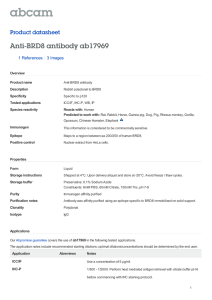
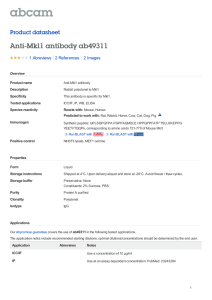
![Anti-SRC3 antibody [0.T.198] ab14139 Product datasheet 2 References 1 Image](http://s2.studylib.net/store/data/012079745_1-e421056a446d20f5f749bfe9b64c5aa3-300x300.png)
